We’ve all seen them and wondered. Every gadget suppler has a small electric fridge or cool-box, usually supplied with a cable to run it off a 12V vehicle supply. I’ve even seen some very favourable reviews of these devices, from people with no credentials. Then, last week I needed to cool down various perishable foodstuffs whilst on a road trip, so I bought one. This is a review of this particular unit, but the principles will apply to the whole family of products.
I opted for the Halfords 8-litre cool-box, largely because I knew where to find a Halfords and I knew I’d seen cool-boxes there. I chose the 8L version because I knew the cooling principle they all utilise isn’t very energy efficient; I didn’t want to cool more space than I needed.
The Halfords 8L cool-box is certainly well-made and insulated. It’s very solid, with a hinged lid and catch that suggests quality. This is only to be expected; the Halfords models are not cheap.
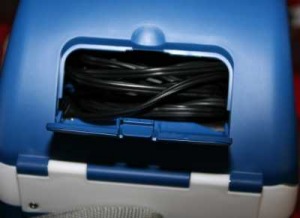
One nice feature of the 8L box is a fitting to hold it securely between two rear seats of a car using the lap belt, allowing it to double as an arm-rest. It’s also small enough to tuck away easily on one side of a boot. After fitting the supplied strap it’s also easy to carry and in another thoughtful touch there’s even a small compartment to store the power cable.
The power lead itself is long enough to reach from the dashboard to the boot without too much trouble and is fitted with a standard lighter plug on one end. The cool-box end of the lead has a proprietary connecting plug fitted, which might be tricky if a replacement is needed. Halfords do sell spare leads, but they’re not cheap!
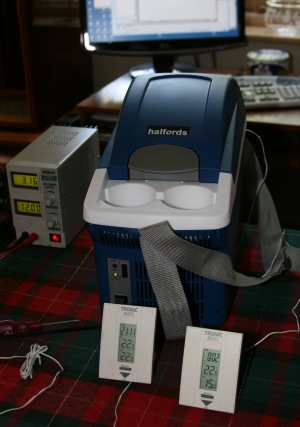
Halfords also sells a mains adapter for something like £25 – ouch! This is one of the most expensive 12V adapters I’ve seen, but the cool-box is rated at 3A so you do need something a bit chunky. I decided against this purchase.
So far so good – the food was loaded into the cool-box and off we went with the cooler running while the engine was on. 3A is no problem for a car’s alternator but I didn’t want to drain the battery. The instructions also made it clear that running of the battery alone wasn’t a good idea.
However, at the end of the day’s driving, which amounted to several hours, it wasn’t at all clear that the inside of the box was any cooler than the outside. On our return I decided to test it properly to see what was going on.
Theory
These coolers all work using a thermoelectric effect. If you really want to know /how/ this works try looking up the Peltier or Seebeck effects in a good physics textbook. The short story is that if you take two plates made of different metals and place them together you can make a heat pump. As heat passes from the hot plate to the cold plate it generates a potential difference (voltage) between them. This is one of those electrical effects that works both ways, so if the plates are the same temperature and you pass a current across the plates they’ll drag heat from one plate to the other. In other words, is you pass a current through the two plates one gets hot by taking heat from the other, which gets cold.
This sounds very useful! All you need to do is place the plate that’s getting cold inside the box, and cool the plate that’s outside the box with a fan. This gives you a fridge with no moving parts apart from a fan, and as moving parts go, fan’s are a lot easier to manage than compressors and the associated plumbing for the coolant. Unfortunately there’s a snag – it’s not a particularly efficient process. Just how efficient it was in practice, I decided to find out.
Testing
Using a lab power supply and a several thermometers with remote probes to measure temperatures inside and outside the box I left the subject running while empty, after sealing down the lid. The inside and outside temperatures were recorded, with the inside being measured by the temperature of the plate.
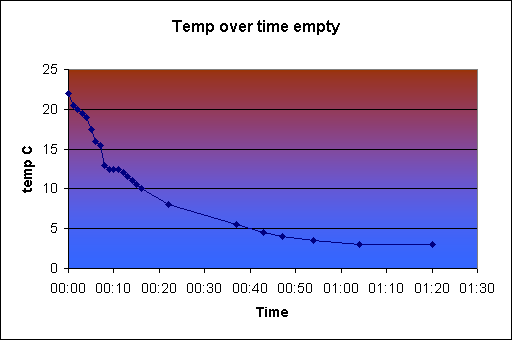
The manufactures claim that it can reduce the temperature of the contents by up to 20C compared to the outside. With the normal summer temperature tending to be 20-25C and a reasonable fridge temperature being 5-10C this would certainly be a suitable performance even allowing for a margin implied by the ‘up to’ preceding the actual figure stated.
The actual performance is shown in Graph 1. As you can see, after about an hour the temperature inside dropped from the ambient 22C outside to just 3C inside, where it stabilised; a drop of 19C. Pretty impressive! But remember the 3A current drain – it turns out it needs 3A constantly so you definitely can’t run this without taking power off the engine. Sill, once cooled it should stay cool for a reasonable period, right? Actually, wrong. Take a look at Graph 2.
After disconnecting the power it returned to room temperature in about 20 minutes. Very disappointing!
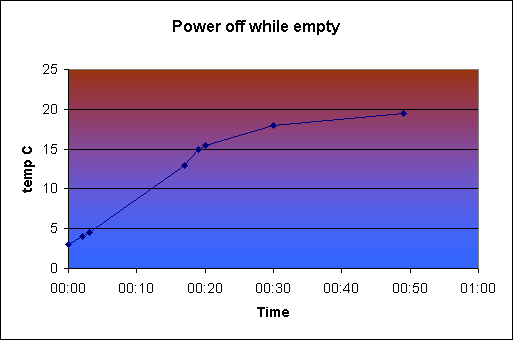
However, this isn’t really a good test, is it? Who needs to cool down a empty box – you really need to cool the contents, and what matters is how long the contents then stay cool once the power is removed. To test this I chose to use 1.5L of water in a sealed plastic box as the payload.
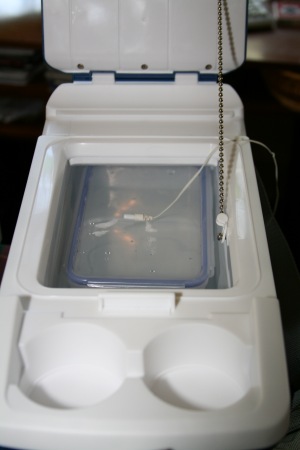
This choice was largely governed by the sealed plastic boxes I had available. There wasn’t space for 2L of water, so 1.5L was a compromise to make calculations easer – and besides, 1.5L or 1.5Kg of food is a reasonable payload for an 8L box. The results can be seen in Graph 3 below.

As you can see, after a full hour the temperature had only fallen by 3C – not much good to anyone. I decided to keep the experiment running for a further eight hours, during which the payload’s temperature eventually stabilised at 10C below ambient. The graph shows the measured temperature a bit lower, but by this stage the outside temperature had also dropped, so it was 10C less.
This isn’t really much good for cooling food down; even after running it all day it’s unable to reach ‘refrigerator’ temperature; your food wouldn’t last long. The only useful thing you can do with it is put pre-cooled items in it and hope they stay that way due to the insulation, because even with the power full on it’s only going to stabilise at about 10C . Graph 4 shows what happened.
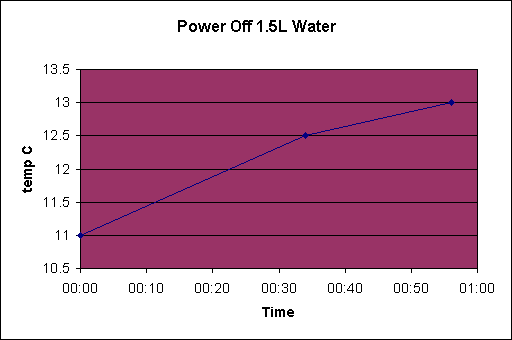
As you can see, thanks to the insulation of the box it does at least manage to keep its contents cool. The tests were carried out away from the wind and sun – ideal conditions, but only sensible.
Conclusion
This is a nicely made piece of equipment, but its real-world performance makes it completely unsuitable for its intended purpose. The best you can say is that if you place cold items in it, it’ll keep them cool as long as you keep it supplied with a lot of power. If you don’t use the electric cooler it’ll work almost as well thanks to its insulated construction.
If you are looking for a workable solution to the problem, and insulated box and a block of ice will easily out-perform this arrangement, at far lower purchase and running costs. The low-tech conventional cool-box (Esky) and freezer pack still has a lot going for it. Don’t waste your money on one of these.
Halfords refunded my money very quickly.


Interesting reading your review. I bought this very coolbox today, it’s my second one. The first one I dropped and afterwards it was unusable but before I dropped it I used it in both my car and in my friends spare room where I stayed for a while. In the car I found it good if going on a reasonably journey of 60 miles one way where the coolbox cooled the drinks down nice and cold. A shorter journey then an ice bag would be needed. In my friends spare room using the 240v adaptor (£14) it would get very cold, as good as a fridge I thought. I kept milk, cheese, coleslaw, coke cans and butter in it and I was never disappointed hence the reason for buying another, this time it’s just for use in the car. And yes, if you leave it on in a permanent live 12v socket in your car it WILL drain the battery very quickly. A bit of advice when using the 240v adaptor, the adaptor gets very hot ( this is normal, it is heat dissipation ) but what I did is lay the adaptor in front on the coolbox (out) fan and this kept it cooler. The change in electric current has to be dissipated somehow and is usually by heat or sound, turn your lights dimmer to the lowest setting and you will hear it gently buzz. I recommend the Halfords 8L coolbox.
Thank you so much. A brilliant review and a lot of hard work that you have generously shared. It’s such reviews on YouTube etc that keep the human side of “great” in the internet. As for Mr Chong, such fun. Well done all. I shall save my money and stick to cool blocks and search for a decent insulated box.
Thanks Frank I was about to purchase one of these cooler boxes. I think I will save my money.As for Mr Chong , I have no sympathy.
thanks frank know nothing about physics or chinese cuiseen but will not be buying one of these boxes for my new (ish) mazda bongo japanese import (please dont review these as ive already paid deposit.) cant always get lumps of ice,unless your camping in alaska then problem doesnt arise. carol ps i want to keep butter not beer
Hi,
After reading your superb review halfords cancelled the order for these boxes at my factory in the quiloon province of china.
now all my workers are starving and are having to eat their own pets to stay alive.
i curse you and your excellent methodology.
lots of love.
Mr Chong.
Your workers are the architects of their own misfortune. State-run capitalism and refrigeration do not mix well. They should have paid proper attention in their physics lessons rather than studying the works of the Chairman. Furthermore, as a vegetarian, I cannot condone them using their pets for sustenance. In surveys, at least 8 out of 10 cats agree.
Might I suggest you diversify in to making solid state solar-powered electronic water softeners, which are, of course, based on sound science and every home should have one.
In the mean time, in solidarity with your workers against the capitalist pig Halfords and the reactionary forces advocating warm beer, I am sending a bottle of Soy sauce which I hope will make their improvised meals more palatable, for the workers if not the pets. Curse it – the label says in was made in China in the first place.
Thanks for your appreciation John. When I did these tests I was more concerned with trying to find out if it was my imagination, or whether these really were as useless as they seemed. It would be interesting to investigate further, but I was in a hurry to return the thing and get my money back!
In general answer to your questions, with the 1.5L of water test the temperature reached equilibrium at about 11C. If you started with pre-chilled contents they’d rise to 11C, if they were warmer they’d fall (stating the obvious). When it comes to how long they’d take to rise, I didn’t do that test but given the relatively slow rise in temperature from 11C when the power was cut you can extrapolate that it’d be quite slow. Based on some figures I didn’t publish above, it may take something like a day before the payload rises from 5C to 10C.
However, it’s not possible to say how this compares with a standard cool-box, as no such thing exists, as far as I know. (That’s a hostage to fortune, I’m sure. There’s probably an ISO committee defining “standard coolbox” as I write). The test was also based on my arbitrary plastic box containing 1.5L of water, out of the sun, in still air and with a stable ambient temperature. Results will vary greatly depending on what you actually have in it. Heavy stuff with a small surface area loses heat faster that light stuff with a large surface area. And then it’ll depend on how the food is wrapped, and so on, and so on.
This particular Halfords box was well insulated and well made; I’ll give it that. If you’re desperate to see a point in it, I’m happy that for the same level of insulation it WILL keep things cooler for longer than an entirely passive equivalent. However, it won’t keep things at fridge temperature for more than a day or so, meaning it’s not suitable for the intended purpose. I’ve kept frozen food frozen for a day by putting it in a cheap insulated bag, covering it with a blanket and keeping it out of the sun.
If I was in any doubt that the marginal improvement the electric cooling provides was worth it, it’d be dispelled by the fact that this sucker needs a continuous 3A to run. This is a fair whack to ask a vehicle alternator to supply while the engine is running – impractical from batteries. You couldn’t keep stuff acceptably cool for a day because you couldn’t realistically power it. Unless, of course, you run it from the mains. In that case you’d be better off with a regular fridge.
Thanks Frank, this is an EXCELLENT bench-test and answers most of the questions prospective purchasers want to know but which the box instructions and salesmen don’t, or won’t answer! There is one more test I am surprised you didn’t run having set it all up. How long it took a full box load of pre-chilled food to rise to say 12c in the electric cool box as compared with the same setup in a standard cool box. That would seem to be the only advantage that these cooler boxes offer – extended cooling of already chilled items over and above standard cool box efficiency. Additionally it would be interesting to see such time tests comparing standard cool boxes with high insulation thermos flask (with glass inner). Putting a pint of milk in a litre flask already half-filled with a plastic bag of ice (or some of those reusable plastic ice-cube shapes) would probably keep it fresh far longer than either coolbox or coolerbox. If anyone knows of any comparison tests elsewhere on the web please do say.
Many thanks for your efforts.
Johndone